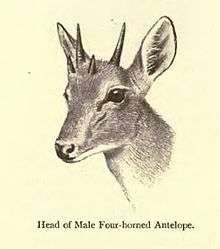Boselaphini
| Boselaphini | |
|---|---|
 | |
| Nilgai | |
 | |
| Four-horned antelope | |
| Scientific classification | |
| Kingdom: | Animalia |
| Phylum: | Chordata |
| Class: | Mammalia |
| Order: | Artiodactyla |
| Family: | Bovidae |
| Subfamily: | Bovinae |
| Tribe: | Boselaphini |
| Genera | |
|
and see text. | |
Boselaphini is a tribe of antelopes belonging to the subfamily Bovinae of the family Bovidae. It contains only two extant genera.
Description
The Boselaphini or four-horned antelope tribe are the last survivors of a form very similar to that of the ancestors of the entire subfamily. The oldest fossil members of the tribe, such as Eotragus, date to the Miocene about 16 to 18 million years ago. Such fossils possessed horns very similar to those of males belonging to the two living species, although in some cases, they were also present in females.[1]
Both extant species have relatively primitive anatomical and behavioural characteristics and the females have no horns. They are native to the rapidly diminishing forests of India, and tend to avoid open plains. The nilgai has been introduced into southern Texas where a population of a little under 15,000 animals provides some long-term insurance for its survival.
Genera
The following are the genera classified under the tribe. Genera marked with † are extinct.[2]
Tribe Boselaphini
- Boselaphus
- Boselaphus tragocamelus - Nilgai or blue bull (not to be confused with the extinct bluebuck Hippotragus leucophaeus)
- †Elachistoceras
- †Duboisia
- †Dystychoceras
- †Eotragus
- †Kipsigicerus
- †Mesembriportax
- †Miotragocerus
- †Pachyportax
- †Perimia
- †Phronetragus
- †Pliodorcas
- †Plioportax
- †Proboselaphus
- †Protragocerus
- †Ruticeros
- †Samokeros
- †Selenoportax
- †Sivaportax
- †Sivoreas
- †Strogulognathus
- Tetracerus
- Tetracerus quadricornis - Four-horned antelope[3]
- †Tragoportax
- †Tragoreas
See also
References
- ↑ Kostopoulos, D.S. (2005). "The Bovidae (Mammalia, Artiodactyla) from the late Miocene of Akkaşdaği, Turkey" (PDF). Geodiversitas. 27 (4): 747–791.
- ↑ Haaramo, M. "Mikko's Phylogency Archive (Boselaphini)". Retrieved 25 March 2011.
- ↑ Leslie, D.M. & Sharma K. (2009). "Tetracerus quadricornis (Artiodactyla: Bovidae)". Mammalian Species. 843: 1–11. doi:10.1644/843.1.